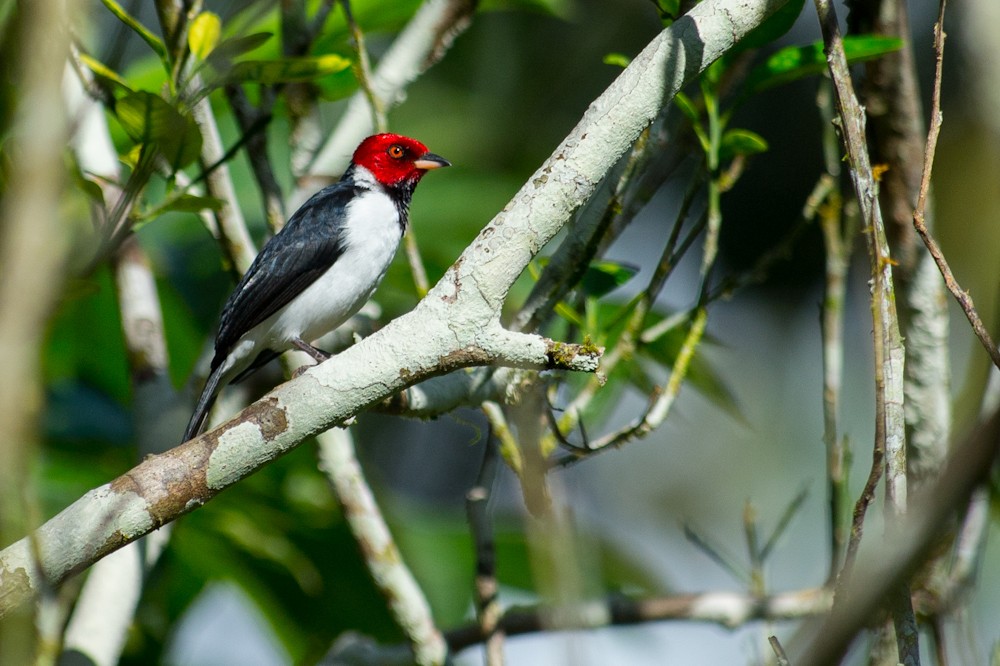Red-capped Cardinal
A species of Cardinal-tanagers Scientific name : Paroaria gularis Genus : Cardinal-tanagers
Red-capped Cardinal, A species of Cardinal-tanagers
Botanical name: Paroaria gularis
Genus: Cardinal-tanagers
Content
Description General Info
Description
The adult red-capped cardinal is 16.5 cm (6.5 in) long and weighs about 22 g (0.78 oz). The nominate subspecies has a crimson head, blackish lores and ocular region, and shiny black upperparts, apart from a white partial collar extending up the neck sides from the white underparts. The throat is black, extending to a point on the upper chest. The upper mandible is black, while the lower is pale flesh-coloured. The legs are dark grey (almost black) and the iris is brownish-orange. In pattern the juvenile resemble the adults, but the upperparts are dusky-brown, the head is deep brownish-buff (darker on the cap), the bill is entirely black and the iris is pale, dull creamy-yellow. The song is a variable, often repeated series of suweet-chu notes, and the call is a sharp chep. 
Size
16 cm
Life Expectancy
5.8-10 years
Nest Placement
Tree
Feeding Habits
Red-capped Cardinal primarily feeds on seeds, berries, and insects, exhibiting varied foraging techniques. This bird has no unique dietary adaptations but does show a preference for certain seeds over others during feeding times.
Habitat
Red-capped Cardinal typically inhabits areas close to water bodies, thriving in riparian thickets and dense vegetation near lakes, ponds, and rivers. Its environment includes second-growth scrub, river-edge, and secondary forests, as well as várzea grasslands and forests, which are seasonally flooded landscapes. These birds are often associated with cochas, highlighting their preference for wet, vegetated regions that provide ample food sources and nesting opportunities.
Dite type
Granivorous
General Info
Feeding Habits
Bird food type
Behavior
The red-capped cardinal feeds on insects, rice and fruit. It is usually found in conspicuous pairs or family groups. If there is a well-marked breeding season, it extends over much of the year. The red-capped cardinal has been recorded to breed at least from June to September in northern South America but at Sacha Lodge at the Napo River (Ecuador) an adult was seen feeding a fledgling shiny cowbird (a brood parasite) in late March. This suggests that breeding can also occur as early as February/March. There is no indication for a difference in breeding seasons between the red-capped and the masked cardinals. They build a shallow open cup nest, some 9–10 cm (3.5–3.9 in) wide and 7 cm (2.8 in) high outside with a 7 cm (2.8 in) wide by 4 cm (1.6 in) deep cup, in a tree or some other secure spot. In Ecuador, a nest in the Cuyabeno Wildlife Reserve was built in the roots of a Macrolobium sp. standing in water, while one at Sacha Lodge was 4 m (13 ft) above ground in a tree. For nest material, it uses rootlets, thin twigs, and ferns. The clutch is two or three eggs. These have a background colour varying between whitish and dull olive and have dense dark brown flecks and blotches, heavier at the blunt end. They measure about 21.5 mm × 16 mm (0.85 in × 0.63 in). This species is parasitised by the shiny cowbird (Molothrus bonariensis). 
Distribution Area
It occurs in lowlands of the Guianas, Venezuela, eastern Colombia, eastern Ecuador, eastern Peru, northern and eastern Bolivia and the Amazon basin in Brazil. In Brazil it is, except for populations in the relatively open lowlands of north-eastern Roraima and along the Branco River and lower Rio Negro, apparently largely absent from the regions north of the northern bank of the Amazon River, but these regions are generally very poorly known and its presence cannot be discounted, especially in the section between the lower Rio Negro and Rio Jari (the river on the border between Pará and Amapá). This is a bird of swamps, mangrove, várzea and other semi-open areas near water. It is generally common, and even occurs in lightly wooded wet habitats in towns or cities (e.g. Manaus and Puerto Maldonado). 
Species Status
Not globally threatened.
Scientific Classification
Phylum
Chordates Class
Birds Order
Perching birds Family
Tanagers Genus
Cardinal-tanagers Species
Red-capped Cardinal 